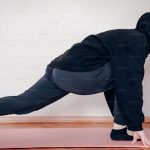Salamba sarvangāsana, or shoulder stand, can be a thing of beauty – it combines strength, flexibility and balance in one scrumptious, iconic pose. Children do them. How hard can they be? Answer – very hard. Actually, incredibly hard! As a novice yogi I remember the indignity of trying to launch my feet over my head and failing miserably – time and time again… Eventually my efforts resulted in balancing precariously on my upper back with my chin embedded in my chest and legs flapping in the breeze. I felt like a claustrophobic apostrophe – not exactly the elegant inversion I had hoped for.
Somewhat dismayed, I reflected on my failure and planned a new path. A path of baby steps towards more serene shoulder stands. It is a path I am still travelling but here are some of the early steps on my pathway. These simple poses will bring you closer to super shoulder stands.
1. BRAHMA MUDRA
This practice is thought to increase concentration and focus as well as improve energy levels. But, because it uses neck movements it also mobilises the neck to allow a greater range of movement. The movement of neck flexion (looking down) is the one that is needed for a comfortable and safe shoulder stand, more movement in the other directions is a bonus!
To try it – sit comfortably looking straight ahead. Ground through the sit bones and grow tall through the crown of the head. Rest hands on legs with shoulders and arms relaxed. Take a hand mudra if you wish. Turn the head to look to the right then left before coming back to the centre – the eyes looking in the direction of movement helps to lead the rotation. Next, lift the chin to look up as far as comfortable then take the chin to the chest – here the eyes go the opposite way to the face. So, look to the nose when the chin tilts up and look your forehead when chin goes down towards the chest. Aim for the movements to be comfortable, slow and fluid through the whole sequence. Breathe normally throughout or link the breath with movement as you wish. Repeat a few times for maximum benefit to range of movement.
As your neck gets more mobile you can roll the flexion into the upper back by pushing the chin a little deeper into the chest. It is this range of movement that you need in your neck to shoulder stand comfortably.
2. SETU BANDHA SARVANGĀSANA
Setu bandha sarvangāsana (bridge pose) is a great way to get your body used to supporting itself on your upper back and shoulders – just as you need to in shoulder stand. Start lying on your back with the knees bent and feet flat on the foot as close to your bottom as comfortable. Knees and feet should be hips width apart at the start and throughout the pose – they have a tendency to drift out if not supervised! I like to encourage posterior (backward) pelvic tilt first by pressing the lower back into the mat and feeling the pelvis roll the buttocks away from the floor. Continue that roll to peel the spine off the floor one bone at a time. Aim to keep the abs engaged so that they lift the hips rather the glutes pushing from behind. As the pelvis lifts you will feel yourself roll up on to your upper back.
There is the option to walk your shoulder blades together underneath you and clasp you hands behind your back to stretch the chest and shoulders. Alternatively you can bend the elbows so that the fingers point to towards the ceiling and press firmly through the elbows to engage the muscles round the shoulder blades. This is the same action in the arms as you need in shoulder stand. Some people are able bendy enough to place their hands in the small of their back in a bridge to support the pelvis, again, just like you do in shoulder stand.
3. USTRĀSANA
Ustrāsana (camel) mimics the arm position you need to get into to achieve a shoulder stand but because there is minimal weight through them so is often much more comfortable. Start kneeling up with knees hips width apart and lower legs parallel. Feet can be flat or toes tucked under – your choice. Place the palms of your hands on your upper buttocks with fingers pointing to the floor if you can. Gently draw the lower ribs towards the pelvis to prepare. Inhale and lift the breast bone as you draw your shoulder blades and elbows together behind you. Keeping tall through the crown of the head, push the hips forwards as you arch the upper back over an imaginary high jump pole at about bra strap height. Keep all that activation in the shoulder blades and arms as you hold for a few breaths. There is the option to release the hands back to hold the heels if you can reach.
4. PRASARITTA PADOTTANĀSANA B
This version of the wide legged forward fold has the hands on the hips and the elbows drawing backwards as if they are trying to touch behind you. As in camel, the chest lists and shoulder blades and elbows draw together before the body folds forwards at the hips. The legs should be super active and working to lift the sit bones towards the ceiling. Keep the head in line with the body and keep growing long through the crown of the head – resist the temptation to curl the head towards the knees. Adding a strap looped just above the elbows before moving into the pose adds a wonderful extra stretch to the shoulders and chest here.
5. CORE STRENGTH
Shoulder stands need a super-strong core to keep your hips balanced over your shoulders. Any versions of plank or side plank will build the right strength. Gently drawing the lower ribs towards the pelvis to prevent rib flare in all backbends also works wonders to activate the right muscles. As does scooping the belly towards the spine in down dog and engaging the base in all warrior poses. Even standing in a lovely active tadāsana, or mountain pose, for a few breaths is adding to the powerhouse that you need to rock inversions like shoulder stand.
So, the path to perfect inversions is long and not always paved with gold. Successes may be small and infrequent but it is a truly lovely journey full of delicious heart-opening and confidence building. And, after all is said and done, yoga is a journey not a destination. Enjoy that journey and reap the benefits that patient and mindful practice will bring. I certainly am. And I can nearly do a presentable shoulder stand too – it really does work!













